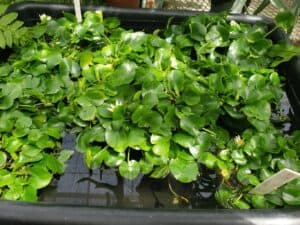Nymphaea thermarum

Resurrecting the Miniature: Propagating the World’s Smallest Water Lily (Nymphaea thermarum)
The Nymphaea thermarum, affectionately known as the "thermal water lily", captivates with its delicate beauty and its fascinating backstory. Sadly extinct in the wild, this miniature marvel, with pads smaller than a dime, survives thanks to dedicated botanists and enthusiasts. If you’re intrigued and have a green thumb itching for a challenge, you might be wondering: can I propagate this rare beauty?
The answer is a cautious yes, but it’s not for the faint of heart. Here’s a glimpse into the fascinating, and somewhat tricky, world of propagating Nymphaea thermarum.
Understanding the Challenges
Before diving into techniques, it’s important to understand why propagating the thermal water lily is so challenging:
- Seeds are scarce: With the plant extinct in its natural habitat (hot springs in Rwanda), seeds are a rarity, usually only available through specialist nurseries or research institutions.
- Specific germination requirements: Unlike many water lilies that germinate easily, the thermal lily requires a very precise set of conditions, mimicking its natural hot spring environment.
- Expert care: Even after germination, successfully raising seedlings to maturity demands a high level of care and controlled conditions.
Propagation Methods
Despite the challenges, two primary methods exist:
- Source your seeds: Your best bet is to connect with reputable nurseries specializing in aquatic plants or reach out to botanical gardens involved in conservation efforts.
- Mimic the hot spring: The key to germinating these seeds lies in replicating their natural habitat. This means:
- Warm temperatures: Aim for a constant water temperature between 77-82°F (25-28°C). Aquarium heaters are essential for maintaining this.
- High humidity: Place your germination setup in a propagator or a covered container to ensure high humidity levels.
- Nutrient-poor substrate: Use a thin layer of inert substrate like sand or very fine gravel. Fertilizers are not recommended at this stage.
- Patience is key: Germination can take several weeks, and even then, success isn’t guaranteed.
- Division (Not Recommended for Beginners)
While technically possible, dividing established Nymphaea thermarum plants is incredibly challenging and best left to experienced growers.
Caring for Your Propagated Plants
Successfully germinating a thermal water lily is a huge accomplishment, but the journey doesn’t end there. Young plants require:
- Consistent warm temperatures and high humidity.
- Bright, indirect light: Avoid direct sunlight, which can scorch the delicate leaves.
- Careful watering: Use dechlorinated or rainwater to prevent harming the sensitive roots.
- Transitioning: As plants grow, they’ll need larger containers and eventually, a permanent aquatic home.
A Rewarding Challenge
Propagating Nymphaea thermarum is undoubtedly a challenging endeavor. However, the reward of helping to preserve this unique and beautiful species can be immensely fulfilling. If you’re up for the task, arm yourself with patience, research, and a passion for conservation. Your efforts, no matter how small, contribute to keeping the world’s smallest water lily blooming.